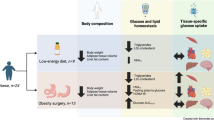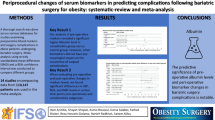Abstract
Objective
The role of liver fatty acid-binding protein (FABP1) in obesity is presently unclear. We investigated the association of FABP1 with obesity and the changes noted after laparoscopic sleeve gastrectomy (LSG) in a Chinese population.
Methods
The cross-sectional analysis included 187 individuals: 65 had normal weight (18.5 ≤ body mass index (BMI) < 24 kg/m2), 59 were overweight (24 ≤ BMI < 28 kg/m2), and 63 were obese (BMI ≥ 28 kg/m2). We also assessed 25 severely obese patients (BMI, 38.58 ± 4.59 kg/m2) at baseline and at 3, 6, and 12 months after LSG to observe FABP1 levels.
Results
FABP1 levels in the obese (30.33 ± 23.59 ng/ml, **P < 0.01, ***P < 0.001) and overweight (18.96 ± 18.75 ng/ml, P = 0.471) individuals were significantly higher than those in normal weight individuals (14.30 ± 9.37 ng/ml). Linear regression analysis revealed that the FABP1 levels were positively correlated with BMI (R2 = 0.201, ***P < 0.001), ALT (R2 = 0.324, ***P < 0.001), AST (R2 = 0.387, ***P < 0.001), m-AST (R2 = 0.160, ***P < 0.001), γ-GT (R2 = 0.106, ***P < 0.001), DBil (R2 = 0.078, ***P < 0.001), UA (R2 = 0.111, ***P < 0.001), FBG (R2 = 0.066, ***P < 0.001), LDL (R2 = 0.042, **P = 0.005), and were negatively correlated with HDL (R2 = 0.051, **P = 0.002). After adjusting for age, sex, ALT, AST, TC, TG, HDL, LDL, FBG, and UA, FABP1 was independently correlated with BMI (*P < 0.05). With decreasing BMI after LSG, the FABP1 levels (29.46 ± 21.19 ng/ml, P = 0.463, P = 0.06, *P < 0.05) also decreased at 3 (23.00 ± 22.77 ng/ml), 6 (14.41 ± 15.48 ng/ml), and 12 months (11.55 ± 3.27 ng/ml).
Conclusion
Serum FABP1 levels are closely correlated with obesity and many metabolic factors, and we found that with the decrease in BMI after LSG, the FABP1 levels also progressively decreased postoperatively.
Trial Registration
ClinicalTrials.gov Identifier: ChiCTR-OCS-12002381




Similar content being viewed by others
References
McArthur MJ, Atshaves BP, Frolov A, et al. Cellular uptake and intracellular trafficking of long chain fatty acids. J Lipid Res. 1999;40(8):1371–83.
Wang G, Bonkovsky HL, de Lemos A, et al. Recent insights into the biological functions of liver fatty acid binding protein 1. J Lipid Res. 2015;56(12):2238–47.
Hotamisligil GS, Bernlohr DA. Metabolic functions of FABPs--mechanisms and therapeutic implications. Nat Rev Endocrinol. 2015;11(10):592–605.
Binas B, Erol E. FABPs as determinants of myocellular and hepatic fuel metabolism. Mol Cell Biochem. 2007;299(1–2):75–84.
Prinetti A, Mitro N. FABP1 in wonderland. J Neurochem. 2016;138(3):371–3.
Hostetler HA, McIntosh AL, Atshaves BP, et al. L-FABP directly interacts with PPARalpha in cultured primary hepatocytes. J Lipid Res. 2009;50(8):1663–75.
McIntosh AL, Huang H, Storey SM, et al. Human FABP1 T94A variant impacts fatty acid metabolism and PPAR-alpha activation in cultured human female hepatocytes. Am J Physiol Gastrointest Liver Physiol. 2014;307(2):G164–76.
Kaikaus RM, Chan WK, Ortiz de Montellano PR, et al. Mechanisms of regulation of liver fatty acid-binding protein. Mol Cell Biochem. 1993;123(1–2):93–100.
Hostetler HA, Balanarasimha M, Huang H, et al. Glucose regulates fatty acid binding protein interaction with lipids and peroxisome proliferator-activated receptor α. J Lipid Res. 2010;51(11):3103–16.
de Jonge C, Rensen SS, Koek GH, et al. Endoscopic duodenal-jejunal bypass liner rapidly improves plasma parameters of nonalcoholic fatty liver disease. Clin Gastroenterol Hepatol. 2013;11(11):1517–20.
Petrescu O, Fan X, Gentileschi P, et al. Long-chain fatty acid uptake is upregulated in omental adipocytes from patients undergoing bariatric surgery for obesity. Int J Obes. 2005;29(2):196–203.
Jahansouz C, Xu H, Hertzel AV, et al. Partitioning of adipose lipid metabolism by altered expression and function of PPAR isoforms after bariatric surgery. Int J Obes. 2018;42(2):139–46.
Shivakumar S, Tantia O, Goyal G, et al. LSG vs MGB-OAGB-3 year follow-up data: a randomised control trial. Obes Surg. 2018;28(9):2820–8.
Atshaves BP, Martin GG, Hostetler HA, et al. Liver fatty acid-binding protein and obesity. J Nutr Biochem. 2010;21(11):1015–32.
Mechanick JI, Kushner RF, Sugerman HJ, et al. American Association of Clinical Endocrinologists, The Obesity Society, and American Society for Metabolic & Bariatric Surgery medical guidelines for clinical practice for the perioperative nutritional, metabolic, and nonsurgical support of the bariatric surgery patient. Obesity. 2009;17 Suppl 1:S1–70. v
Kellerer T, Brandl B, Buttner J, et al. Impact of laparoscopic sleeve gastrectomy on gut permeability in morbidly obese subjects. Obes Surg. 2019;29:2132–43.
Gao J, Zhang M, Zhu C, et al. The change in the percent of android and gynoid fat mass correlated with increased testosterone after laparoscopic sleeve gastrectomy in Chinese obese men: a 6-month follow-up. Obes Surg. 2018;28(7):1960–5.
Wang X, Li L, Zhu C, et al. Alteration of bone mineral density differs between genders in obese subjects after laparoscopic sleeve gastrectomy: bone morphogenetic protein 4 may count. Obes Surg. 2018;28(10):3221–6.
Pelsers MM, Hermens WT, Glatz JF. Fatty acid-binding proteins as plasma markers of tissue injury. Clin Chim Acta. 2005;352(1–2):15–35.
Noiri E, Doi K, Negishi K, et al. Urinary fatty acid-binding protein 1: an early predictive biomarker of kidney injury. Am J Physiol Ren Physiol. 2009;296(4):F669–79.
Nakamura T, Sugaya T, Kawagoe Y, et al. Effect of pitavastatin on urinary liver-type fatty acid-binding protein levels in patients with early diabetic nephropathy. Diabetes Care. 2005;28(11):2728–32.
Karvellas CJ, Speiser JL, Tremblay M, et al. Elevated FABP1 serum levels are associated with poorer survival in acetaminophen-induced acute liver failure. Hepatology. 2017;65(3):938–49.
Milligan S, Martin GG, Landrock D, et al. Ablating both Fabp1 and Scp2/Scpx (TKO) induces hepatic phospholipid and cholesterol accumulation in high fat-fed mice. Biochim Biophys Acta Mol Cell Biol Lipids. 2018;1863(3):323–38.
McIntosh AL, Atshaves BP, Martin GG, et al. Effect of liver fatty acid binding protein (L-FABP) gene ablation on lipid metabolism in high glucose diet (HGD) pair-fed mice. Biochim Biophys Acta Mol Cell Biol Lipids. 2019;1864(7):985–1004.
Binas B, Erol E. FABPs as determinants of myocellular and hepatic fuel metabolism. Mol Cell Biochem. 2007;299(1):75–84.
Ong KT, Mashek MT, Davidson NO, et al. Hepatic ATGL mediates PPAR-α signaling and fatty acid channeling through an L-FABP independent mechanism. J Lipid Res. 2014;55(5):808–15.
He J, Tian Y, Li J, et al. Expression pattern of L-FABP gene in different tissues and its regulation of fat metabolism-related genes in duck. Mol Biol Rep. 2013;40(1):189–95.
Dharmarajan S, Newberry EP, Montenegro G, et al. Liver fatty acid-binding protein (L-Fabp) modifies intestinal fatty acid composition and adenoma formation in ApcMin/+ mice. Cancer Prev Res. 2013;6(10):1026–37.
Newberry EP, Kennedy SM, Xie Y, et al. Decreased body weight and hepatic steatosis with altered fatty acid ethanolamide metabolism in aged L-Fabp -/- mice. J Lipid Res. 2012;53(4):744–54.
Pelsers MM, Morovat A, Alexander GJ, et al. Liver fatty acid-binding protein as a sensitive serum marker of acute hepatocellular damage in liver transplant recipients. Clin Chem. 2002;48(11):2055–7.
Van Nieuwenhoven FA, Verstijnen CP, Van Eys GJ, et al. Fatty acid transfer across the myocardial capillary wall: no evidence of a substantial role for cytoplasmic fatty acid-binding protein. J Mol Cell Cardiol. 1994;26(12):1635–47.
Nielsen SE, Sugaya T, Tarnow L, et al. Tubular and glomerular injury in diabetes and the impact of ACE inhibition. Diabetes Care. 2009;32(9):1684–8.
Kamijo-Ikemori A, Sugaya T, Yasuda T, et al. Clinical significance of urinary liver-type fatty acid-binding protein in diabetic nephropathy of type 2 diabetic patients. Diabetes Care. 2011;34(3):691–6.
Shi J, Zhang Y, Gu W, et al. Serum liver fatty acid binding protein levels correlate positively with obesity and insulin resistance in Chinese young adults. PLoS One. 2012;7(11):e48777.
Lamhonwah AM, Tein I. GFP-human high-affinity carnitine transporter OCTN2 protein: subcellular localization and functional restoration of carnitine uptake in mutant cell lines with the carnitine transporter defect. Biochem Biophys Res Commun. 1999;264(3):909–14.
Turnbaugh PJ, Bäckhed F, Fulton L, et al. Diet-induced obesity is linked to marked but reversible alterations in the mouse distal gut microbiome. Cell Host Microbe. 2008;3(4):213–23.
Nakanishi Y, Murashima K, Ohara H, et al. Increase in terminal restriction fragments of Bacteroidetes-derived 16S rRNA genes after administration of short-chain fructooligosaccharides. Appl Environ Microbiol. 2006;72(9):6271–6.
Thumser AE, Moore JB, Plant NJ. Fatty acid binding proteins: tissue-specific functions in health and disease. Curr Opin Clin Nutr Metab Care. 2014;17(2):124–9.
Funding
This study is supported by the National Key R&D Program of China (No.2018YFC1314100). This research was also supported by the National Natural Science Foundation of China (NSFC 81700752, 81500687, 81601269, 81970677).
Author information
Authors and Affiliations
Corresponding authors
Ethics declarations
Conflict of Interest
The authors declare that they have no conflict of interest.
Informed Consent
Informed consent was obtained from all participants included in the study.
Ethical Approval
The study was approved by the ethics committee of Shanghai Tenth People’s Hospital.
Additional information
Publisher’s Note
Springer Nature remains neutral with regard to jurisdictional claims in published maps and institutional affiliations.
Rights and permissions
About this article
Cite this article
You, H., Wen, X., Zhu, C. et al. Serum FABP1 Levels Correlate Positively with Obesity in Chinese Patients After Laparoscopic Sleeve Gastrectomy: a 12-Month Follow-up Study. OBES SURG 30, 931–940 (2020). https://doi.org/10.1007/s11695-019-04307-3
Published:
Issue Date:
DOI: https://doi.org/10.1007/s11695-019-04307-3




